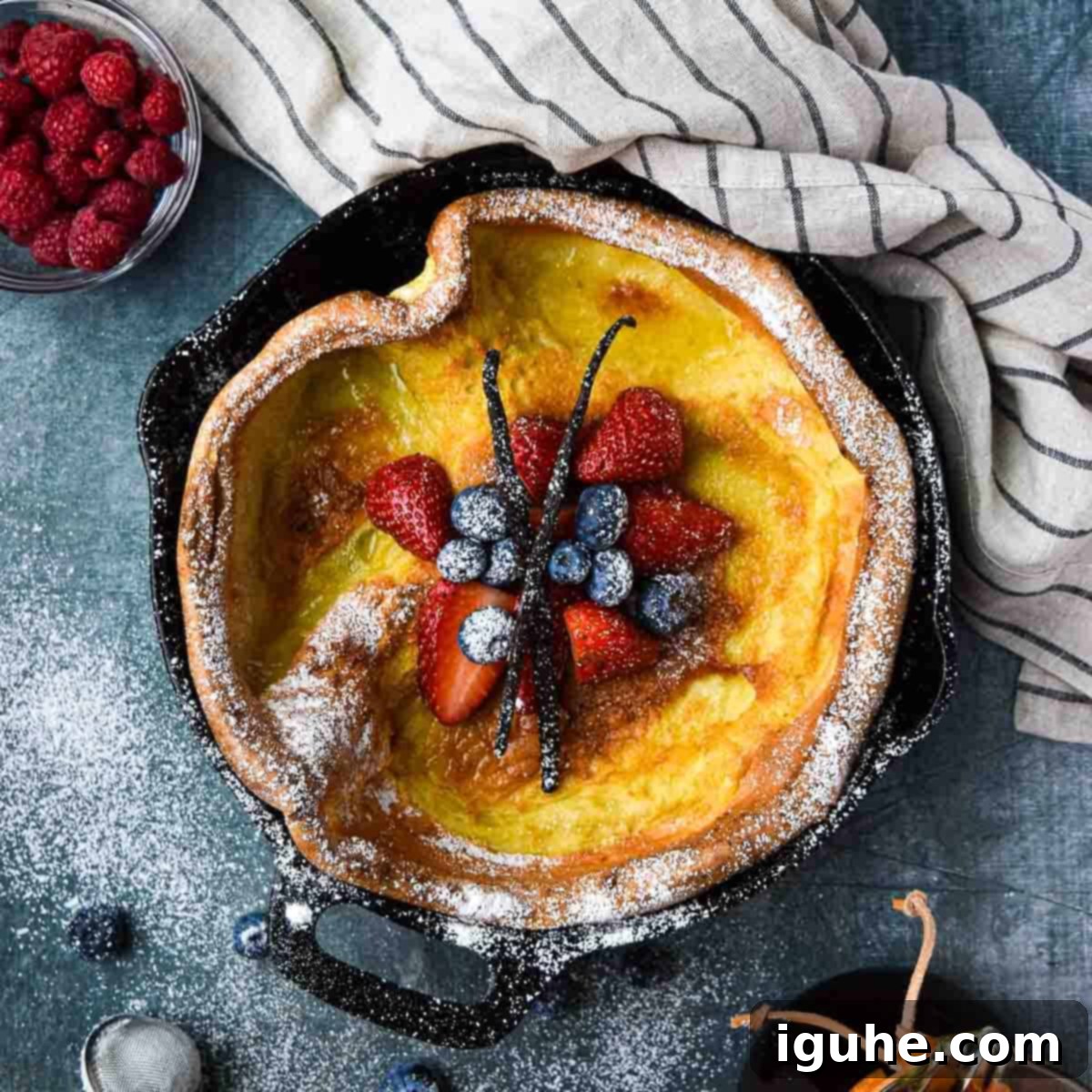The Ultimate Guide to Making a Fluffy Sweet Vanilla Dutch Baby Pancake
Are you searching for an impressive yet incredibly easy breakfast or brunch recipe that’s guaranteed to be a showstopper? Look no further than this delightful Sweet Vanilla Dutch Baby Pancake. Imagine a generously proportioned, sky-high, buttery, and utterly puffy pancake that emerges from your oven ready to be devoured. Infused with warm vanilla and a hint of cinnamon, this sweet puff pancake offers a gourmet experience without the fuss, making it perfect for both leisurely mornings and festive gatherings. Serve it straight from the hot pan and let everyone customize it with their favorite toppings for a truly personalized and memorable meal.
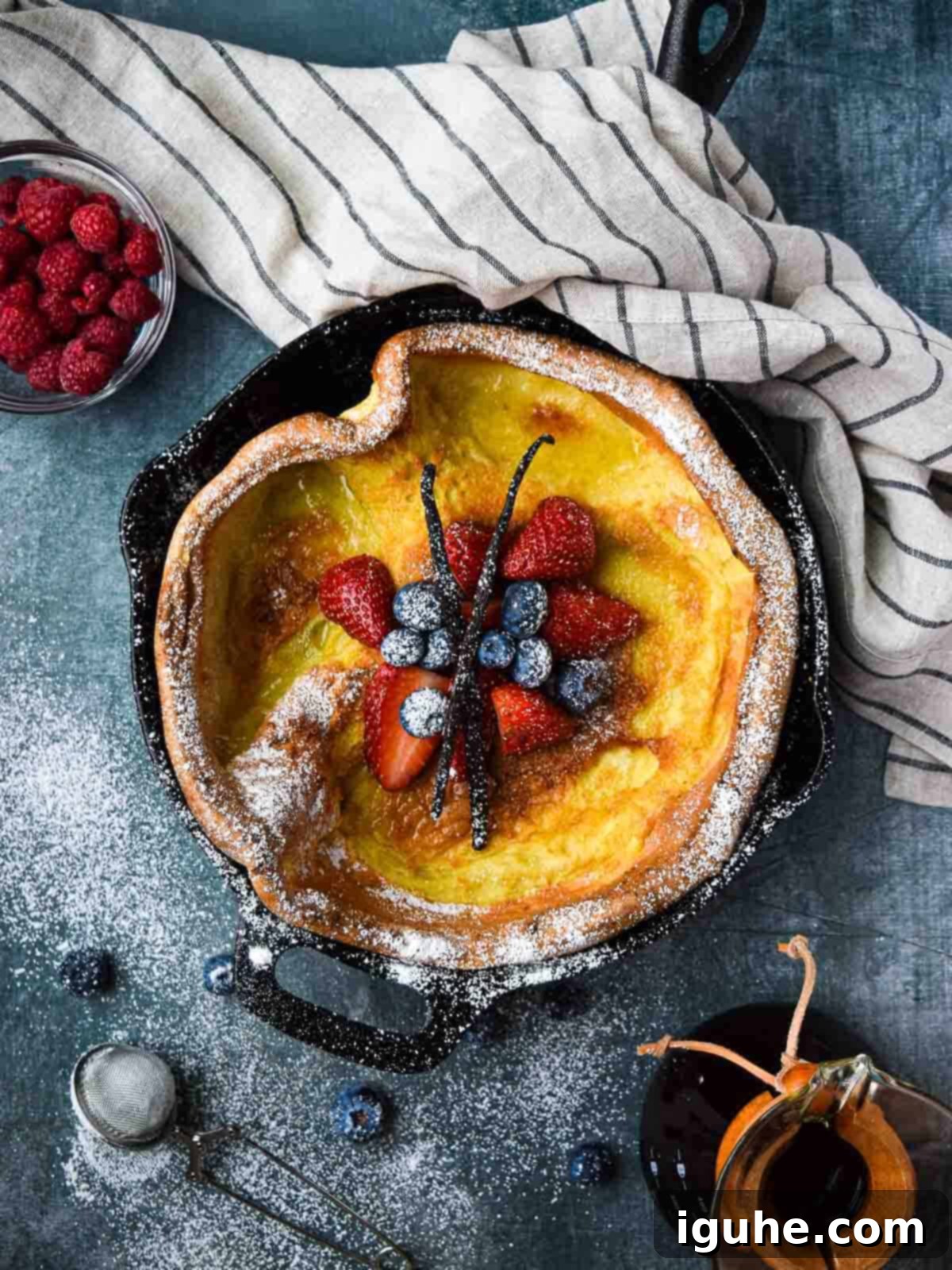
If you, like many home cooks, dislike the constant chore of standing over the stove flipping individual pancakes when entertaining guests, then the Dutch baby pancake is your culinary savior. This magnificent one-skillet breakfast is not only incredibly delicious but also visually stunning, requiring minimal effort for maximum impact. It’s an elegant solution for feeding a crowd or simply treating yourself to a spectacular start to the day.
What Exactly is a Dutch Baby Pancake?
Often referred to by various charming names such as Bismarck, Hootenanny, Dutch Puff, or German pancake, a Dutch baby is a unique culinary creation that stands distinctly apart from its American pancake cousins. It’s best described as a delightful hybrid, possessing the delicate thinness and crisp edges reminiscent of a crepe, the impressive puffy rise of a popover, and the savory richness found in a traditional Yorkshire pudding. However, unlike traditional American pancakes which rely on chemical leavening agents like baking powder or baking soda, the Dutch baby achieves its dramatic, sky-high puff entirely through trapped steam.
The magic happens in a preheated, piping hot pan. When the simple, egg-rich batter is poured into this scorching hot environment, the moisture within the batter rapidly converts into steam. This steam expands, pushing the batter upwards and creating those signature tall, billowy walls and a deep, inviting center. This incredible rise is temporary; the pancake will gracefully deflate as it cools after being removed from the oven. The result is a wonderfully light, airy crust that gives way to a tender, almost custard-like interior. While its taste is slightly richer and more eggy than a typical pancake or crepe, its versatility allows it to be served in much the same way as any traditional breakfast pancake, making it a perfect canvas for both sweet and savory toppings.
Essential Ingredient Notes for Your Perfect Dutch Baby
One of the many appealing aspects of making a Dutch baby is that it typically requires only a handful of common pantry staples. You likely already have most, if not all, of these ingredients on hand, ready to transform into a spectacular breakfast. Here’s a closer look at what you’ll need and why each component is important:
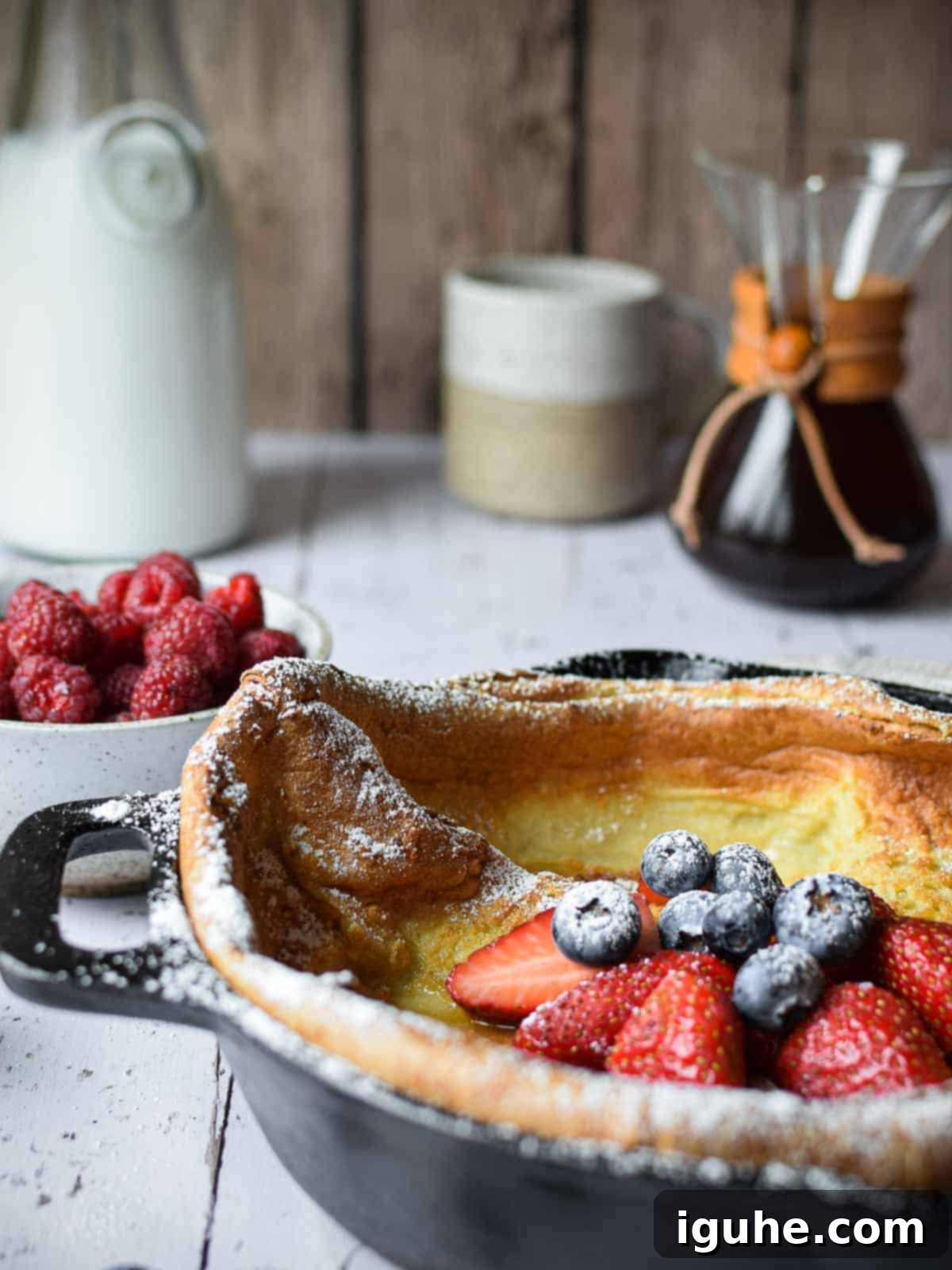
- Eggs: Use large eggs. Eggs are the structural backbone of the Dutch baby, providing the richness and enabling the dramatic puff. For the best results and a smooth batter, ensure your eggs are at room temperature. This helps them incorporate more easily with other ingredients.
- Flour: Standard all-purpose flour is ideal for achieving the perfect texture and rise. Avoid using self-rising flour, as it contains leavening agents that are not needed for this recipe and can alter the desired outcome.
- Milk: I typically use 2% milk, but nearly any milk variety will work beautifully, including whole milk, skim milk, or even non-dairy alternatives like almond or oat milk. The fat content can subtly affect the richness, but the structure will remain consistent. Room temperature milk, like eggs, helps create a smoother, lump-free batter.
- Sugar: Powdered sugar (also known as confectioner’s sugar) is my preferred choice. Its fine texture means it dissolves effortlessly into the batter, ensuring even sweetness without a grainy texture. Granulated sugar can also be used, but powdered sugar provides a silkier batter.
- Vanilla: This is where the “Vanilla” in Sweet Vanilla Dutch Baby shines! Opt for a good quality pure vanilla extract or, for an even more intense flavor and visual appeal, vanilla bean paste. Please, resist the temptation to use imitation vanilla; the authentic flavor truly makes a difference in this simple yet elegant dish.
- Cinnamon: Just a touch of ground cinnamon adds a warm, inviting spice note that beautifully complements the vanilla. It’s subtle but elevates the overall flavor profile, making it feel extra comforting.
- Salt: A small amount of Kosher or sea salt is crucial. It acts as a flavor enhancer, balancing the sweetness from the sugar and bringing out the depth of the vanilla and cinnamon. Don’t skip it!
- Butter: Unsalted butter is best. It provides a rich, golden crust and prevents the pancake from sticking to the hot pan. Using unsalted butter allows you to control the overall saltiness of the dish precisely.
For precise quantities, please refer to the detailed recipe card provided below.
Mastering the Art of Making a Dutch Baby Pancake
If you can whisk a few ingredients together, you can confidently make a Dutch baby. In fact, many find it even simpler than traditional pancakes because there’s no flipping involved! The key to its signature puff lies in a few crucial steps. Follow these instructions to create your own magnificent sweet vanilla Dutch baby:
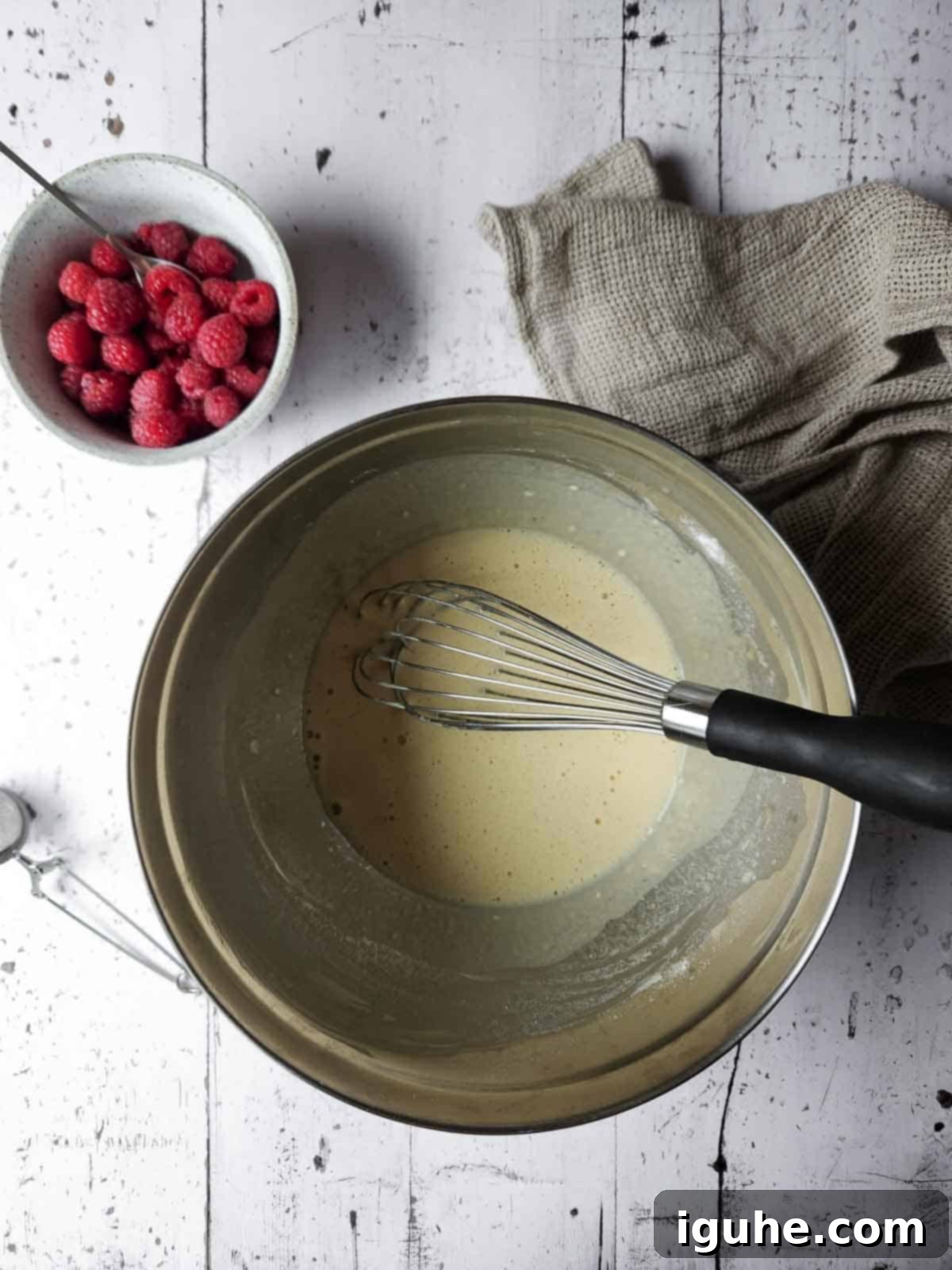
Step 1: Preheat and Prepare. Begin by preheating your oven to a robust 425°F (220°C). This high temperature is vital for triggering the steam needed for the dramatic rise. Simultaneously, place your empty cast iron skillet or other oven-safe pan into the oven while it preheats. This ensures the pan is scorching hot when the batter is added, which is absolutely critical for a successful puff. While the oven and pan are heating, you can comfortably prepare your batter.
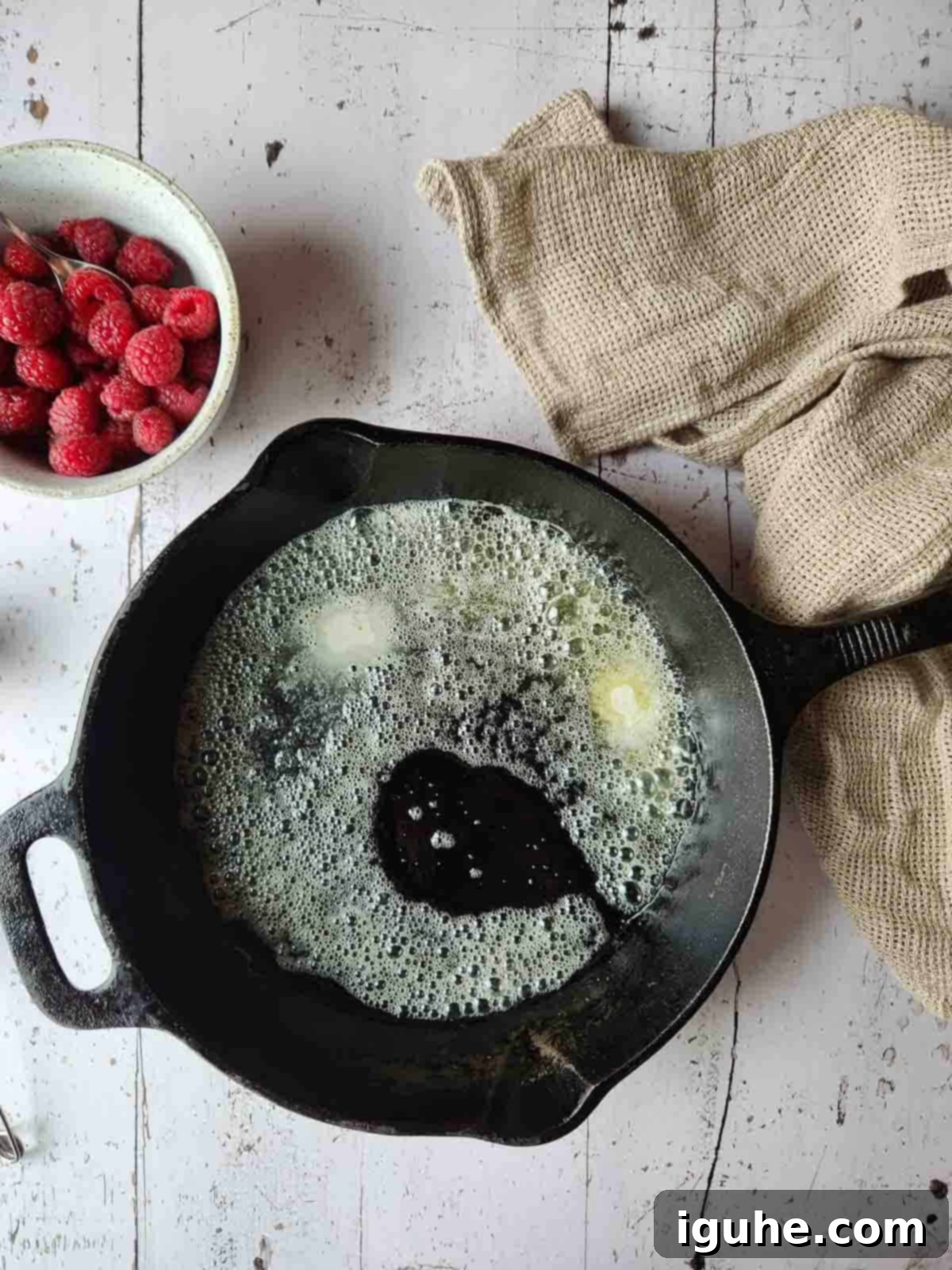
Step 2: Whisk Your Batter. In a medium bowl, combine all the wet and dry ingredients (eggs, flour, milk, salt, powdered sugar, vanilla extract, and cinnamon). Whisk vigorously until the batter is completely smooth and free of lumps. Alternatively, for an even quicker and smoother batter, you can use a blender: simply add all ingredients and pulse until well combined, scraping down the sides as needed. Allow the batter to rest for at least 10-15 minutes while the oven finishes preheating. This resting period allows the flour to fully hydrate, resulting in a more tender pancake.
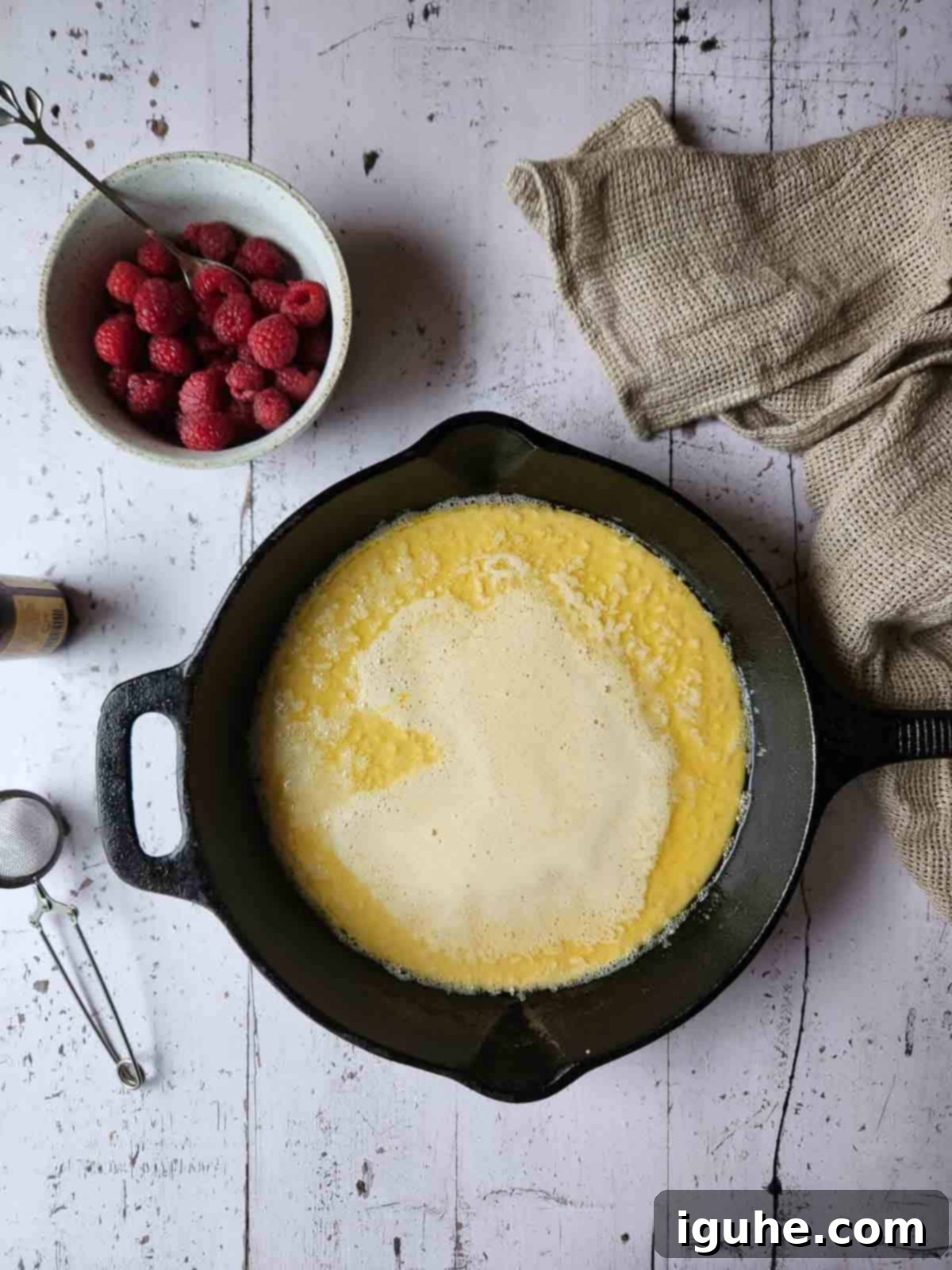
Step 3: Melt the Butter. Once your oven has reached temperature and your pan is screaming hot, carefully remove the pan from the oven. Add the unsalted butter to the hot pan. Watch as it sizzles and melts almost instantly, coating the bottom and sides. Ensure the butter is fully melted and bubbling before proceeding to the next step. This melted butter is essential for creating a non-stick surface and contributing to the crispy edges of the Dutch baby.
Step 4: Pour and Bake. With the pan still incredibly hot and the butter bubbling, swiftly pour the prepared batter directly over the melted butter. There’s no need to stir or swirl. Immediately return the skillet to the preheated oven. Bake for approximately 18-20 minutes. You’ll know it’s ready when the edges are dramatically puffed up, golden brown, and delightfully crispy, while the center might still have a slightly softer, more custardy texture. The most important rule during baking is: Do not open the oven door! Opening the door allows heat to escape, which can cause your beautiful puff to deflate prematurely. If you need to check on it, use the oven light.
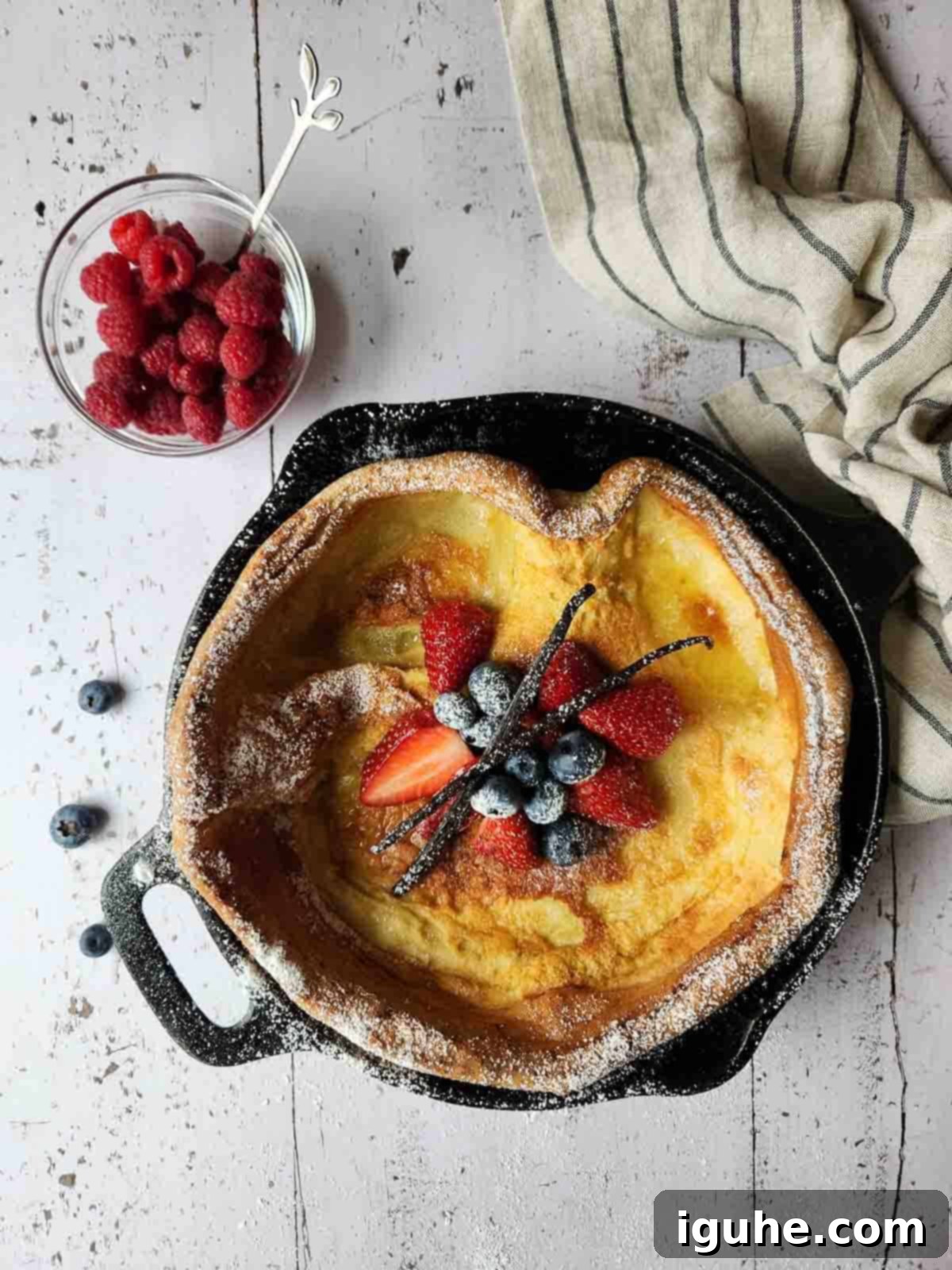
Step 5: Serve Immediately. Once baked to golden perfection, carefully remove the skillet from the oven. Your Dutch baby will be beautifully puffed and impressive. As it cools, it will naturally begin to deflate, creating a lovely “bowl” in the center – this is perfectly normal and expected. Top it with your desired fruits, a dusting of powdered sugar, or a generous drizzle of maple syrup, and serve it straight from the pan. The immediate serving ensures you enjoy the warm, fresh texture at its absolute best.
Hot Pan Alert: Always remember that your pan will be extremely hot from the oven. Exercise extreme caution when handling it, especially when removing it to melt the butter and pour the batter, and again when taking out the finished pancake. Use oven mitts or thick kitchen towels to protect your hands.
Exciting Ways to Serve Your Sweet Vanilla Dutch Baby
One of the most enjoyable aspects of a Dutch baby pancake is its versatility. The dramatic rise leaves a beautiful, billowy bowl-shaped depression right in the center, which is absolutely perfect for holding an abundance of delicious toppings. This allows for endless customization, making each serving a unique experience. Here are some fantastic ideas to serve with your sweet vanilla pancake:
- Fresh Fruit Medley: Elevate this simple dish with vibrant, fresh berries such as blueberries, strawberries, raspberries, or sliced bananas. The contrasting colors and juicy sweetness add a wonderful fresh dimension and a beautiful presentation. You can even warm the berries slightly for a comforting touch.
- Classic Powdered Sugar: For a timeless and elegant finish, keep it simple with a generous dusting of confectioner’s sugar. It adds just the right amount of sweetness and a delicate, snowy appearance.
- Warm Fruit Compote or Jam: Spoon your favorite fruit jam or a homemade fruit compote (like apple, peach, or cherry) into the center. The warmth of the pancake will beautifully melt and blend with the fruit spread, creating a delightful burst of flavor.
- Nutty Crunch: Add a lovely textural contrast with some toasted nuts. Sliced almonds, chopped walnuts, or pecans would be excellent choices, providing a satisfying crunch and earthy flavor. A sprinkle of granola can also work wonders!
- Maple Syrup & Honey: It is a pancake after all, so don’t be shy with a generous drizzle of high-quality pure maple syrup. For a different kind of sweetness, a swirl of honey can also be incredibly delicious, especially when paired with fruit.
- Whipped Cream or Ice Cream: For a truly decadent treat, a dollop of freshly whipped cream or a scoop of vanilla bean ice cream melting into the warm center takes this Dutch baby from breakfast to dessert in an instant.
- Lemon Zest & Juice: A sprinkle of fresh lemon zest and a squeeze of fresh lemon juice can brighten the flavors, cutting through the richness and adding a lovely tanginess that pairs wonderfully with vanilla.
Looking for something savory to serve alongside your sweet pancake to create a balanced brunch spread? Why not try this sweet and savory rosemary and fig candied bacon for an unforgettable meal.
Essential Equipment for Your Perfect Puff Pancake
The right pan is crucial for achieving that characteristic dramatic rise and beautiful golden crust of a Dutch baby pancake. While the recipe is simple, the equipment plays a significant role in its success. You will need a sturdy, oven-proof pan with tall sides to accommodate the batter as it puffs up in the oven.
My go-to choice, and one I highly recommend, is a trusty 10-inch cast iron skillet. Cast iron is exceptional because of its superior heat retention capabilities. It gets incredibly hot and stays hot, which is precisely what’s needed to create the burst of steam that lifts the Dutch baby so high. The even heat distribution also contributes to a perfectly cooked pancake with crispy edges and a tender center. However, if you don’t own a cast iron skillet, don’t worry! You can use any 9 or 10-inch oven-safe pan with tall sides. This could include a heavy-bottomed stainless steel skillet, a glass pie plate, or a ceramic baking dish. Just ensure that whatever pan you choose can withstand high oven temperatures and has adequate depth to allow the pancake to rise without spilling over.
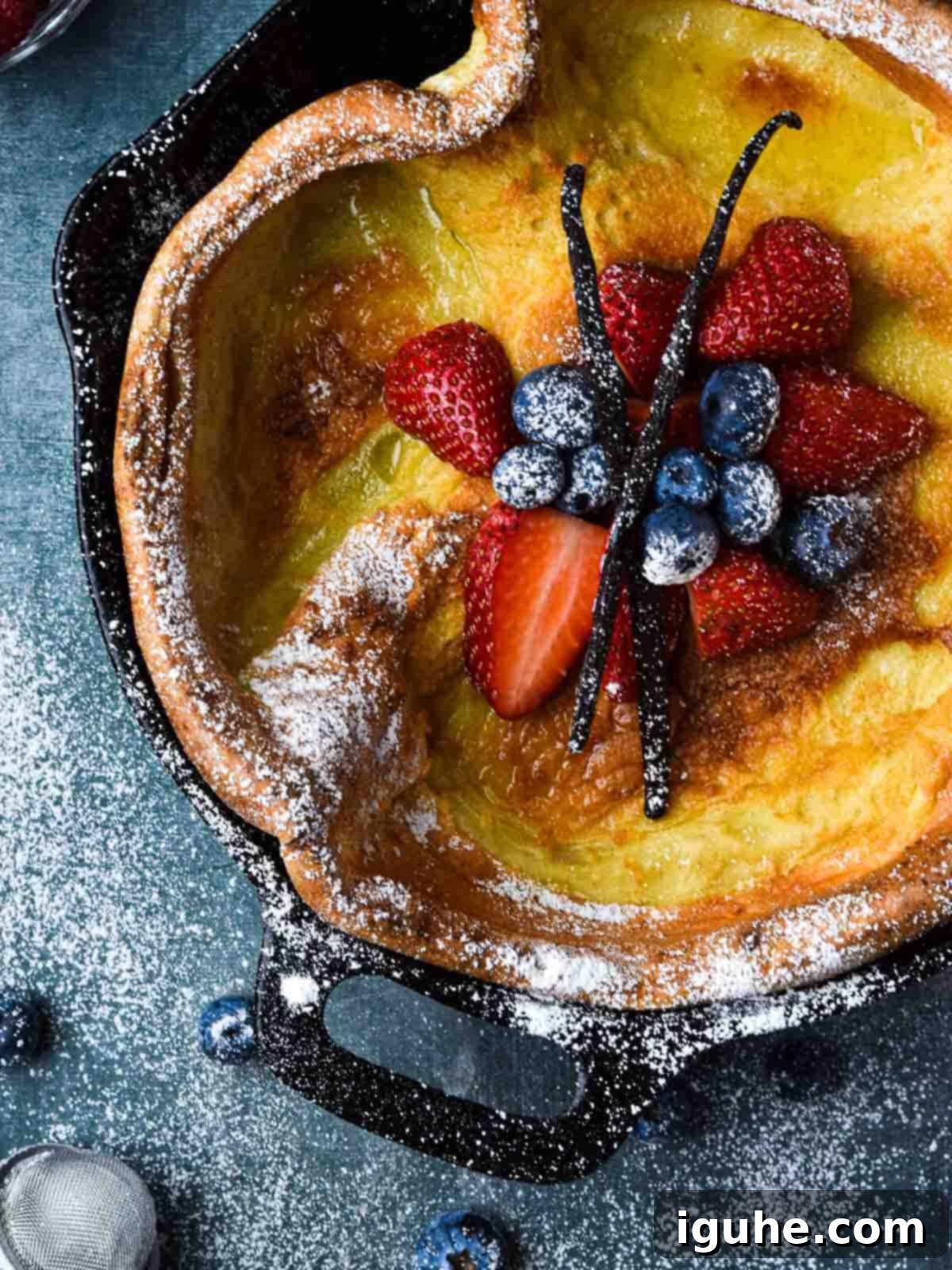
Storing Your Dutch Baby Pancake (and Why You Might Not Need To!)
Now for a bit of bittersweet news: this magnificent puff pancake, while heavenly when fresh, unfortunately does not store well. Believe me, I’ve tried every trick in the book! Reheating leftover Dutch baby pancakes tends to result in a rubbery, dense, and frankly, unappetizing texture the next day. The delicate, airy structure that makes it so special simply doesn’t hold up once it cools and is stored.
The good news, however, is that it’s so incredibly delicious and visually appealing that you’re highly unlikely to have any leftovers in the first place! It’s truly best enjoyed hot and fresh, right out of the oven. If you’re concerned about serving a large group, it’s better to make multiple Dutch babies sequentially rather than trying to store and reheat one large one.
While the cooked pancake isn’t suitable for storage, there’s a fantastic workaround for meal prep: you can easily prepare the batter up to 24 hours in advance. Simply whisk all the ingredients together as instructed, then cover the bowl tightly with plastic wrap and refrigerate it. When you’re ready to bake, give the cold batter a final vigorous whisk to ensure everything is well combined and then proceed with the recipe as usual. This makes for an even quicker and more convenient breakfast on busy mornings!
💡Top Tip for a Sky-High Dutch Baby
The single most critical factor for achieving a beautiful, dramatic puff in your Dutch baby is ensuring your pan is screaming hot, and your butter is completely melted and bubbling before pouring in the batter. This intense heat is what instantly creates the steam needed to inflate the pancake. Don’t rush this step!
Frequently Asked Questions About Dutch Baby Pancakes
Absolutely! While a cast iron skillet is highly recommended for its excellent heat retention, it’s not strictly essential. You can certainly use any 9 or 10-inch pan that is certified oven-safe. This includes heavy-bottomed stainless steel skillets, glass pie plates, or ceramic baking dishes. The most important consideration is to ensure the pan has adequately high sides, allowing ample space for the Dutch pancake to rise majestically without overflowing during its impressive puff in the oven. Always preheat your chosen pan in the oven, just as you would a cast iron skillet, to ensure it’s incredibly hot before adding the batter.
There are a few common culprits if your Dutch baby isn’t puffing up dramatically. The most frequent reason is that your pan and butter were not sufficiently hot when the batter was added. The rapid creation of steam from the hot pan is what drives the impressive rise, so a cool pan will hinder this process. To avoid this, always place your empty pan in the oven at the very beginning of the preheating cycle, allowing it to get intensely hot. Secondly, resist the powerful urge to open the oven door during baking! Each time the oven door is opened, a significant amount of heat escapes, causing the temperature to drop and potentially collapsing the delicate, rising structure of your Dutch pancake. If you must check on its progress, use the oven light to peek without letting out the heat. Ensure your batter is also well-whisked and rested.
Related Breakfast & Brunch Recipes You’ll Love
- Swiss Chard Eggs Florentine with Tomato Hollandaise
- Cinnamon Sweet Cream Pancakes
- Savory Lemon Thyme Popovers
- Double Chai Spiced Pancakes
Did you make this incredible Sweet Vanilla Dutch Baby Pancake? We would absolutely love to hear about your experience! Please take a moment to leave a ⭐⭐⭐⭐⭐ rating and share your thoughts in a comment right below the recipe card. And if you capture a mouth-watering photo of your creation, don’t forget to tag us on Instagram @brunchandbatter. Your feedback and photos truly inspire us!
📖Recipe: Sweet Vanilla Dutch Baby Pancake
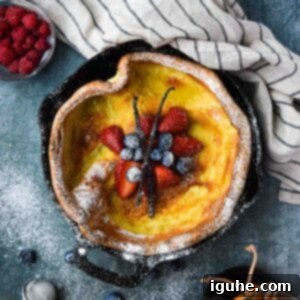
Sweet Vanilla Dutch Baby Pancake
Pin Recipe
Equipment
-
1 10-inch cast iron skillet (or other 10-inch non-stick, oven-safe skillet with tall sides)
Ingredients
- 3 large eggs (preferably at room temperature)
- ½ cup all-purpose flour
- ½ cup milk (any kind, preferably at room temperature)
- ¼ teaspoon Kosher or fine sea salt
- 2 tablespoon powdered (confectioner’s) sugar
- 1 teaspoon pure vanilla extract (or vanilla bean paste)
- ⅛ teaspoon ground cinnamon
- 3 tablespoon unsalted butter
Instructions
-
Preheat your oven to 425°F (220°C). While the oven is preheating, place your empty 10-inch skillet (cast iron or other oven-safe pan) into the oven. It’s crucial for the pan to get very hot to achieve the dramatic puff.
-
In a medium bowl, combine the room temperature eggs, all-purpose flour, milk, Kosher or fine sea salt, powdered sugar, pure vanilla extract, and ground cinnamon. Whisk vigorously until the batter is completely smooth and free of any lumps. Alternatively, for the quickest and smoothest batter, you can combine all ingredients in a blender and pulse until well combined, scraping down the sides as needed. Allow the batter to rest for at least 10-15 minutes while the oven finishes preheating; this helps the flour hydrate for a more tender result.3 large eggs, ½ cup all-purpose flour, ½ cup milk, ¼ teaspoon Kosher or fine sea salt, 2 tablespoon powdered (confectioner’s) sugar, 1 teaspoon pure vanilla extract, ⅛ teaspoon ground cinnamon
-
Once the oven has preheated and your pan is intensely hot, carefully remove the pan from the oven. Add the 3 tablespoons of unsalted butter to the hot skillet and let it melt completely, swirling it to coat the bottom and sides. The butter should be sizzling and bubbling. Immediately pour the prepared batter directly over the melted butter – do NOT stir. Place the skillet back into the oven and bake for 18-20 minutes, or until the edges are dramatically puffed up, golden brown, and delightfully crispy. **Important: Do not open the oven door while the Dutch baby is cooking, as this can cause it to deflate prematurely. Use the oven light to observe its progress.** Once baked, remove from the oven and serve immediately while still warm.3 tablespoon unsalted butter
Notes
- For the best possible puff and to prevent deflation, resist the urge to open the oven door while the Dutch baby is cooking. If you want to keep an eye on its progress, simply leave the oven light on, allowing you to check for doneness without disturbing the internal temperature.
- It’s entirely normal and expected for your puff pancake to rise majestically in the hot oven and then slowly deflate after you take it out. This creates a beautiful “bowl” in the center, which is perfect for holding all your favorite toppings. Serve it immediately to enjoy its wonderful fresh texture.
- To ensure a super smooth batter and prevent lumps, consider using a blender for mixing all the batter ingredients. This method quickly incorporates everything without overmixing.
- Make sure your eggs and milk are at room temperature. This helps them combine more easily with the dry ingredients, resulting in a more uniform and lump-free batter, which contributes to a better rise.
Nutrition*
*Nutrition information is provided as a courtesy and is an estimate only. Nutritional values can vary significantly based on many factors, including specific products used, measurement variations, and ingredient substitutions. For the most accurate nutritional calculations, it is highly recommended that you obtain your own based on the exact ingredients and methods used in your finished recipe.
